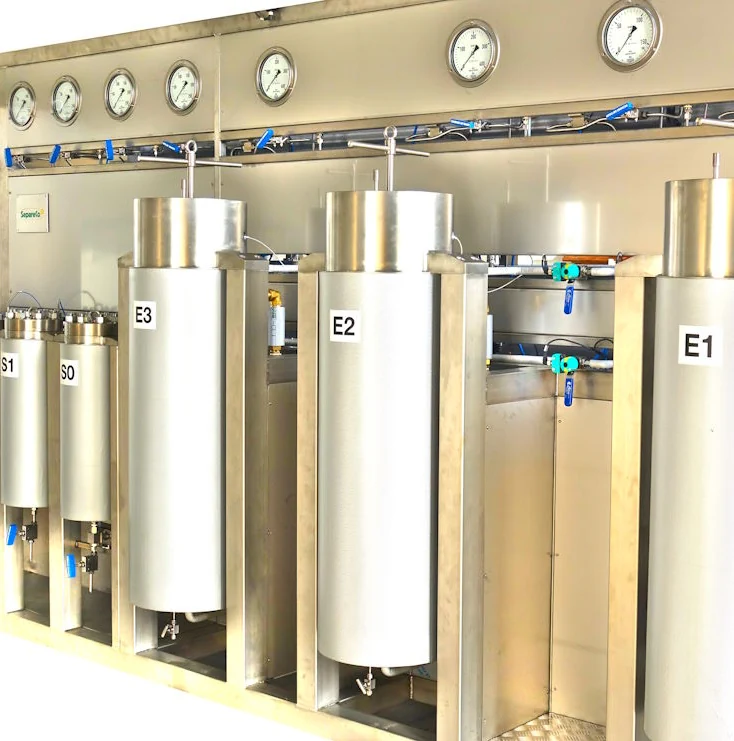How to extract natural products from plants with the supercritical CO2 extraction method
The process of supercritical CO2 extraction in the field of botany fascinates you and you would like to know what are the fundamental principles of this type of extraction? Have you read that the machine that extracts using the characteristics of supercritical CO2 must be equipped with software that needs to know some fundamental parameters and are curious to find out what they are? Or are you interested in delving into the topic of supercritical CO2 extraction technique?
Don’t worry!
Here’s an article that will explain everything about the extraction of natural products from plants using supercritical CO2.
Take a few minutes to read this article that we at Separeco, an Italian company based in Turin, a leader in the production of supercritical CO2 extraction machines, have prepared to explain how the extraction process works and what parameters to consider before starting the extraction process. We will see together how pressure and temperature parameters must be optimal and how important preliminary tests conducted by the operator are.
If you are interested in discovering how the extraction phase occurs, keep reading.
Happy reading!
All the principles of supercritical CO2 extraction
Supercritical fluid extraction applies to solid matrices, the acronym of which is SFE (Supercritical Fluid Extraction). In the case of liquid matrices, we are not talking about extraction but about fractionation, the acronym of which is SFF (Supercritical Fluid Fractionation), but we will deal with this methodology in another article.
First, let’s analyze the general aspects that describe the extraction principles. Extraction from solid matrices with liquid/supercritical solvents, called solid-liquid extraction, allows the desired compounds to be separated from the solid raw material, generally of botanical origin.
Generally, it is necessary to identify the most suitable solvent for the target compounds of the extraction. In our case it will be supercritical CO2. The solvent will occupy all possible spaces and then spread throughout the matrix. The extraction process then begins, generally by diffusion, in which the desired elements pass into the solvent, becoming concentrated.
The conditions or parameters of the process depend on the compounds of interest that are intended to be extracted from the chosen matrix. The supercritical CO2 extraction machine must be equipped with automation software that allows you to enter all these process parameters. A good machine must be able to load these parameters into the process recipes. Each matrix will have one or more process recipes based on the compounds that need to be extracted.
To make a good extraction you need to know:
1) The optimal pair of pressure/temperature to solubilize the target compound.
2) The flow rate of the CO2 pump and, if requested, the flow rate of the cosolvent pump.
3) The characteristics of the raw material
Before starting the extraction of any raw material, it is necessary to know its degree of humidity and grain size. It is necessary to reduce the amount of water contained in the raw material as much as possible, since water slows down extraction. A water content close to 7% is considered optimal. The size of the grind is also very important. A fine grain size of the ground material increases the exchange surface and consequently facilitates extraction. A good value is between 0.6 and 0.9 mm. A size of the ground material that is too small, less than 0.4 mm, can trigger the channeling effect (a channel that forms in the matrix where the supercritical CO2 passes thorough), compromising extraction.
Choosing the right pressure/temperature pair is the first step. Usually the operator refers to scientific publications that will help get closer to the correct values. However, some tests with values close to those published will be necessary to verify the solubility of your own raw material. When possible, low pressures and temperatures will be chosen, which increase the selectivity of the supercritical CO2, avoiding dragging unwanted compounds into the extract. Low temperatures ensure higher densities and so higher solubility power.
Subsequently the operator will have to choose the right flow rate of the CO2 pump. Unfortunately, this value cannot be found in publications. Due to the tiny size of the lab scale apparatus used for testing, volumes of just a few milliliters, this value, once published, is very often too large and therefore unusable in a production machine. This value will have to be found by the operator. It is advisable not to overdo the flow rate. Lower flow rates give better yields as the residence time of the solvent increases. A normal extraction kinetic has a value of 20 or 30 kg of supercritical CO2 per kg of matrix. In rare cases much higher values are justified.
If you are ready to consider the possibility of introducing a supercritical CO2 extraction process, do not hesitate to contact us. We will be happy to explain all the features of our machinery and support you in identifying the equipment that best suits your needs

